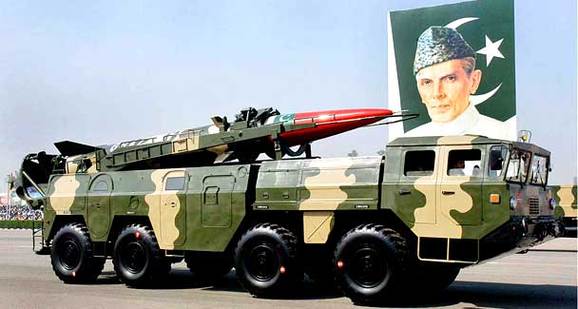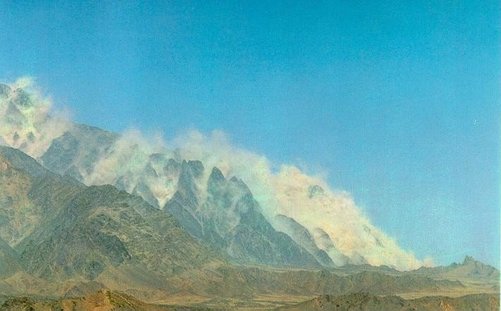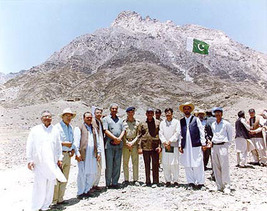Youm-e-Takbir
Youm-e-Takbir (Urdu: یوم تکبیر ) meaning "The day of greatness" is celebrated as a national day in Pakistan on May 28 in commemoration of Chagai-I and Chagai-II when Pakistan detonated six nuclear devices in response to India's five detonations of Pokhran-II in 1998, 17 days after the incident.
Brief History of Pakistan Nuclear Program

The Pakistani nuclear research reactor at Parr, Rawalpindi, began functioning in 1965 with help (via fiscal aid and light-water imports) from the United States. The Nuclear Nonproliferation Treaty was completed in 1968 and garnered the signatures of 189 states. Pakistan refused to sign. Pakistan's nuclear weapons program was established in 1972 by Zulfiqar Ali Bhutto, who founded the program while he was Minister for Fuel, Power and Natural Resources, and later became President and Prime Minister. Shortly after the loss of East Pakistan in the 1971 war with India, Bhutto initiated the program with a meeting of physicists and engineers at Multan in January 1972.
In 1972 Canada supplies Pakistan with a heavy-water reactor for the Karachi Nuclear Power Plant (KANUPP), heavy water as a moderator for the reactor, and a heavy-water production facility. This aid was terminated in 1976.
India tested a device of up to 15 kilotons and called the test a "peaceful nuclear explosion" in 1974. In 1974, Pakistan proposed to India the establishment of a nuclear weapons free zone in south Asia. India rejected the proposal. Pakistani Prime Minister Zulfikar Ali Bhutto told a meeting of Pakistan's top scientists of his intention to develop nuclear arms.
The 1975 arrival of Dr. Abdul Qadeer Khan considerably advanced these efforts. Dr. Khan is a German-trained metallurgist who brought with him knowledge of gas centrifuge technologies that he had acquired through his position at the classified URENCO uranium enrichment plant in the Netherlands.
Dr. Abdul Qadeer Khan, founded Engineering Research Laboratories (ERL) in 1976 to focus on the indigenous enrichment of uranium and the research and design of an atomic weapon.
Pakistan proposed to India a joint Indo-Pakistan declaration renouncing the acquisition and manufacture of nuclear weapons in 1978. This proposal was also rejected.
In 1979, The United States cut off aid to Pakistan under Section 669 of the Foreign Assistance Act of 1961 (FAA) after it was learned that Pakistan had secretly begun construction of a uranium enrichment facility.
In 1985, Pakistan crossed the threshold of weapons-grade uranium production, and by 1986 it is thought to have produced enough fissile material for a nuclear weapon. Pakistan continued advancing its uranium enrichment program, and according to Pakistani sources, the nation acquired the ability to carry out a nuclear explosion in 1987.
In 1980, U.S. Nuclear Export Control statutes were violated by the attempted exportation of components of inverters used in gas centrifuge enrichment activities. Export Control violations occurred again in 1981, when Albert Goldberg was arrested attempting to ship 2 tons of zirconium to Pakistan. Zirconium is used in nuclear reactor operations as nuclear fuel cladding material and can lead to nuclear weapons development.
In 1980, U.S. Nuclear Export Control statutes were violated by the attempted exportation of components of inverters used in gas centrifuge enrichment activities. Export Control violations occurred again in 1981, when Albert Goldberg was arrested attempting to ship 2 tons of zirconium to Pakistan. Zirconium is used in nuclear reactor operations as nuclear fuel cladding material and can lead to nuclear weapons development.
1990 began with reports of secret construction of a new, unsafeguarded nuclear research reactor with components sourced from Europe.
In October of 1990, President Bush announced that he could no longer provide Congress with Pressler Amendment certification that Pakistan does not possess a nuclear weapon. Economic and military aid was duly terminated, though the Bush administration continued to permit a limited number of commercial military sales to Pakistan. Pakistan handled the cutoff with little public rancor and committed itself to freezing the nuclear program in an attempt to placate the United States.
Once again, Pakistan proposed to India the commencement of a multilateral conference on the nuclear proliferation in South Asia. And once again, it was rejected.
After numerous treaty opportunities, India and Pakistan finally entered an agreement prohibiting attacks on each other's nuclear installations. And in July of 1991, reliable reports from Islamabad confirmed that Pakistan had frozen production of HEU and halted the manufacturing of nuclear weapons and components.
Again in September 1995, The Clinton Administration proposed revisions to the Pressler Amendment, citing the Amendment's roadblocks to cooperation with Pakistan's Government in areas such as combatting terrorism and furthering US commercial interests in Pakistan.
On 01 January 1996, India and Pakistan exchanged lists of atomic installations which each side had pledged not to attack under a confidence-building agreement signed in 1988. Both nations will continue to do so on 01 January of every year until the treaty is dissolved.
In January 1996, The Brown amendment was signed into law to relieve some of the pressures created by the Pressler sanctions, which had crippled parts of the Pakistani military, particularly its Air Force. The Brown amendment allowed nearly $370 million of previously embargoed arms and spare parts to be delivered to Pakistan. It also permitted limited military assistance for the purposes of counter-terrorism, peacekeeping, anti-narcotics efforts, and some military training, and allowed the continuation of economic and humanitarian aid.
Pakistan commissioned an unsafeguarded nuclear reactor in Khushab, expected to become operational in the late 1990s, that would provide the country with the capacity to produce weapons-grade plutonium.
In July 1997, Pakistan confirms test firing of new indigenous Hatf missile. A few months later, Pakistani Prime Minister Nawaz Sharif claimed Pakistan possessed nuclear weapons, saying that, "Pakistan's nuclear capability is now an established fact. Whatever we have, we have a right to keep it...."
On May 28, 1998 Pakistan announced that it had successfully conducted five nuclear tests. The Pakistani Atomic Energy Commission reported that the five nuclear tests conducted on May 28 generated a seismic signal of 5.0 on the Richter scale, with a total yield of up to 40 KT (equivalent TNT).
On May 29, 1998, Pakistani Foreign Minister Gohar Ayub Khan said in an interview with the AP that Pakistan is now a nuclear weapons state. Foreign Ministry Secretary Shamshad Ahmad said that Pakistans nuclear weapons capability was meant solely for national self-defense. It will never be used for offensive purposes, he said in a prepared statement.
On 30 May 1998, Pakistan announced that it had tested multiple nuclear warhead, one with a yield of 12 kilotons, bringing the total number of claimed tests to six.
Pakistans Khushab plutonium production reactor was completed and came on-line in 1998.
On June 2, 1998, Pakistani Ambassador Munir Akram called together a Special Session of the Conference on Disarmament. He stated that Pakistan had attempted to bring the South Asian security situation into the light of the international community for some time, but to no avail. He also made clear that Pakistans nuclear program and weapons R&D was only in response to the dangers of combat - including the nuclear threat - emanating from India, the lack of International response to aggression by India against Pakistan, and the need to develop an effective deterrent. Pakistan's main nuclear weapons laboratory, the A.Q. Khan Laboratory in Kahuta, purchased 5,000 ring magnets from China. The ring magnets would allow Pakistan to effectively double its capacity to enrich uranium for nuclear weapons production.
In 1972 Canada supplies Pakistan with a heavy-water reactor for the Karachi Nuclear Power Plant (KANUPP), heavy water as a moderator for the reactor, and a heavy-water production facility. This aid was terminated in 1976.
India tested a device of up to 15 kilotons and called the test a "peaceful nuclear explosion" in 1974. In 1974, Pakistan proposed to India the establishment of a nuclear weapons free zone in south Asia. India rejected the proposal. Pakistani Prime Minister Zulfikar Ali Bhutto told a meeting of Pakistan's top scientists of his intention to develop nuclear arms.
The 1975 arrival of Dr. Abdul Qadeer Khan considerably advanced these efforts. Dr. Khan is a German-trained metallurgist who brought with him knowledge of gas centrifuge technologies that he had acquired through his position at the classified URENCO uranium enrichment plant in the Netherlands.
Dr. Abdul Qadeer Khan, founded Engineering Research Laboratories (ERL) in 1976 to focus on the indigenous enrichment of uranium and the research and design of an atomic weapon.
Pakistan proposed to India a joint Indo-Pakistan declaration renouncing the acquisition and manufacture of nuclear weapons in 1978. This proposal was also rejected.
In 1979, The United States cut off aid to Pakistan under Section 669 of the Foreign Assistance Act of 1961 (FAA) after it was learned that Pakistan had secretly begun construction of a uranium enrichment facility.
In 1985, Pakistan crossed the threshold of weapons-grade uranium production, and by 1986 it is thought to have produced enough fissile material for a nuclear weapon. Pakistan continued advancing its uranium enrichment program, and according to Pakistani sources, the nation acquired the ability to carry out a nuclear explosion in 1987.
In 1980, U.S. Nuclear Export Control statutes were violated by the attempted exportation of components of inverters used in gas centrifuge enrichment activities. Export Control violations occurred again in 1981, when Albert Goldberg was arrested attempting to ship 2 tons of zirconium to Pakistan. Zirconium is used in nuclear reactor operations as nuclear fuel cladding material and can lead to nuclear weapons development.
In 1980, U.S. Nuclear Export Control statutes were violated by the attempted exportation of components of inverters used in gas centrifuge enrichment activities. Export Control violations occurred again in 1981, when Albert Goldberg was arrested attempting to ship 2 tons of zirconium to Pakistan. Zirconium is used in nuclear reactor operations as nuclear fuel cladding material and can lead to nuclear weapons development.
1990 began with reports of secret construction of a new, unsafeguarded nuclear research reactor with components sourced from Europe.
In October of 1990, President Bush announced that he could no longer provide Congress with Pressler Amendment certification that Pakistan does not possess a nuclear weapon. Economic and military aid was duly terminated, though the Bush administration continued to permit a limited number of commercial military sales to Pakistan. Pakistan handled the cutoff with little public rancor and committed itself to freezing the nuclear program in an attempt to placate the United States.
Once again, Pakistan proposed to India the commencement of a multilateral conference on the nuclear proliferation in South Asia. And once again, it was rejected.
After numerous treaty opportunities, India and Pakistan finally entered an agreement prohibiting attacks on each other's nuclear installations. And in July of 1991, reliable reports from Islamabad confirmed that Pakistan had frozen production of HEU and halted the manufacturing of nuclear weapons and components.
Again in September 1995, The Clinton Administration proposed revisions to the Pressler Amendment, citing the Amendment's roadblocks to cooperation with Pakistan's Government in areas such as combatting terrorism and furthering US commercial interests in Pakistan.
On 01 January 1996, India and Pakistan exchanged lists of atomic installations which each side had pledged not to attack under a confidence-building agreement signed in 1988. Both nations will continue to do so on 01 January of every year until the treaty is dissolved.
In January 1996, The Brown amendment was signed into law to relieve some of the pressures created by the Pressler sanctions, which had crippled parts of the Pakistani military, particularly its Air Force. The Brown amendment allowed nearly $370 million of previously embargoed arms and spare parts to be delivered to Pakistan. It also permitted limited military assistance for the purposes of counter-terrorism, peacekeeping, anti-narcotics efforts, and some military training, and allowed the continuation of economic and humanitarian aid.
Pakistan commissioned an unsafeguarded nuclear reactor in Khushab, expected to become operational in the late 1990s, that would provide the country with the capacity to produce weapons-grade plutonium.
In July 1997, Pakistan confirms test firing of new indigenous Hatf missile. A few months later, Pakistani Prime Minister Nawaz Sharif claimed Pakistan possessed nuclear weapons, saying that, "Pakistan's nuclear capability is now an established fact. Whatever we have, we have a right to keep it...."
On May 28, 1998 Pakistan announced that it had successfully conducted five nuclear tests. The Pakistani Atomic Energy Commission reported that the five nuclear tests conducted on May 28 generated a seismic signal of 5.0 on the Richter scale, with a total yield of up to 40 KT (equivalent TNT).
On May 29, 1998, Pakistani Foreign Minister Gohar Ayub Khan said in an interview with the AP that Pakistan is now a nuclear weapons state. Foreign Ministry Secretary Shamshad Ahmad said that Pakistans nuclear weapons capability was meant solely for national self-defense. It will never be used for offensive purposes, he said in a prepared statement.
On 30 May 1998, Pakistan announced that it had tested multiple nuclear warhead, one with a yield of 12 kilotons, bringing the total number of claimed tests to six.
Pakistans Khushab plutonium production reactor was completed and came on-line in 1998.
On June 2, 1998, Pakistani Ambassador Munir Akram called together a Special Session of the Conference on Disarmament. He stated that Pakistan had attempted to bring the South Asian security situation into the light of the international community for some time, but to no avail. He also made clear that Pakistans nuclear program and weapons R&D was only in response to the dangers of combat - including the nuclear threat - emanating from India, the lack of International response to aggression by India against Pakistan, and the need to develop an effective deterrent. Pakistan's main nuclear weapons laboratory, the A.Q. Khan Laboratory in Kahuta, purchased 5,000 ring magnets from China. The ring magnets would allow Pakistan to effectively double its capacity to enrich uranium for nuclear weapons production.
Operation Chagai-1 and Chagai 2

Chagai-I was the codename referring to the five underground nuclear tests conducted by Pakistan at 15:15hrs (3:15 PM) (PST) on 28 May 1998. The tests were performed in a secret Chagai weapon-testing laboratories, located in the Chagai District of the Baluchistan Province of Pakistan.
The Chagai-I the first public nuclear tests operation of Pakistan is considered a milestone in the history of Pakistan that was conducted in a direct response to India's second nuclear tests, Operation Shakti, on 11 and 13 May of 1998. Nuclear weapon testings of both states resulted in a variety of economic sanctions on each other by number of major powers, particularly the United States and Japan. With the performance of the simultaneous atomic testing of the five nuclear devices, Pakistan, thus became the seventh nuclear power in the world to successfully develop and publicly test nuclear weapons, despite the international fury.
Chagai-II was the codename of the second atomic test performed and conducted on 13:10hrs (1:10 P.M) (PST) on 30 May 1998 by Pakistan. It was the second tests performed two days after the first tests were conducted on 28 May and were conducted as part of the tit-for-tat policy. Unlike the Chagai weapon-testing laboratories, the tests were performed in an open test site, the Kharan weapon-testing laboratories.The initial goals were to tests the new designs of the weapon rather than studying the effects and were differed from the first tests as the tests were primary conducted by Pakistan Atomic Energy Commission, with the armed forces' engineering formations having only a supporting role. The single or two device was performed and was a boosted weapon-grade plutonium device as against the first tests that contained only uranium devices. With the performance of the tests made it sum total of six devices having been performed by Pakistan in 1998.
The Chagai-I the first public nuclear tests operation of Pakistan is considered a milestone in the history of Pakistan that was conducted in a direct response to India's second nuclear tests, Operation Shakti, on 11 and 13 May of 1998. Nuclear weapon testings of both states resulted in a variety of economic sanctions on each other by number of major powers, particularly the United States and Japan. With the performance of the simultaneous atomic testing of the five nuclear devices, Pakistan, thus became the seventh nuclear power in the world to successfully develop and publicly test nuclear weapons, despite the international fury.
Chagai-II was the codename of the second atomic test performed and conducted on 13:10hrs (1:10 P.M) (PST) on 30 May 1998 by Pakistan. It was the second tests performed two days after the first tests were conducted on 28 May and were conducted as part of the tit-for-tat policy. Unlike the Chagai weapon-testing laboratories, the tests were performed in an open test site, the Kharan weapon-testing laboratories.The initial goals were to tests the new designs of the weapon rather than studying the effects and were differed from the first tests as the tests were primary conducted by Pakistan Atomic Energy Commission, with the armed forces' engineering formations having only a supporting role. The single or two device was performed and was a boosted weapon-grade plutonium device as against the first tests that contained only uranium devices. With the performance of the tests made it sum total of six devices having been performed by Pakistan in 1998.
Celebrations

Click to enlarge
The day was officially signed by the then Prime Minister of Pakistan Nawaz Sharif. It was first celebrated by giving awards such as Chagai Medal to various individuals and industries in the field of science and industries. The Nawaz Sharif government also established the Chagai I Medal and it was first awarded to the scientists of Pakistan in 1998 who were witnessed the tests. The graphite mountains are visibly shown in the gold medallion and equal ribbon stripes of yellow, red and white.


